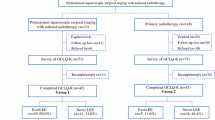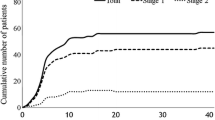Abstract
Purpose
The goal of this study was to investigate clinical manifestations of lower extremity edema (LEE) after lymph node dissection in patients with primary endometrial cancer.
Methods
Women with primary endometrial cancer who underwent staging surgery between November 2001 and March 2011 were included in the study. Medical records and/or responses to the Gynecologic Cancer Lymphedema Questionnaire (GCLQ) were used for LEE evaluation.
Results
All 154 patients underwent pelvic lymph node dissection, and 126 patients (81.8 %) underwent paraaortic LN dissection. The median age of the patients was 52 years, the majority had stage I cancer (78.6 %), and most had endometrioid histology (90.9 %). The most frequent GCLQ responses were “experienced swelling” (35.7 %), “experienced numbness” (30.5 %), “experienced heaviness” (29.9 %), and “experienced aching” (29.9 %). Sixty-four patients (41.6 %) had previous (9/64, 14.1 %) and/or current (55/64, 85.9 %) patient-reported LEE. Most patients developed LEE within 12 months after surgery (39/56, 69.6 %), and LEE lasted for more than 12 months in most patients (45/56, 80.4 %). Three patients reported recurrent LEE after recovery. Multivariate logistic regression identified the number of dissected pelvic lymph node (≥21) as a risk factor for LEE [odds ratio (OR) 3.28; 95 % confidence interval (CI) 1.058–10.136] and postoperative radiotherapy (OR 3.81, 95 % CI 1.67–8.69).
Conclusions
LEE developed in more than one-third of patients with endometrial cancer after surgery, and LEE lasted for more than 12 months in most patients. A high number of dissected pelvic lymph nodes and postoperative radiotherapy is associated with LEE.

Similar content being viewed by others
References
Center, N.C.I. Cancer Incidence. 2011; http://www.cancer.go.kr/mbs/cancer/subview.jsp?id=cancer_040402000000.
Ministry of Health, W.a.F.A., Cancer Registration Statistics. 2013.
Lim MC, et al. Incidence of cervical, endometrial, and ovarian cancer in Korea, 1999–2010. J Gynecol Oncol. 2013;24(4):298–302.
Jung, KW, et al. Prediction of cancer incidence and mortality in Korea. Cancer Res Treat. 2014;46(2):124–30.
Jung, KW, et al. Cancer statistics in Korea: incidence, mortality, survival, and prevalence in 2011. Cancer Res Treat. 2014;46(2):109–23.
Beesley V, et al. Lymphedema after gynecological cancer treatment: prevalence, correlates, and supportive care needs. Cancer. 2007;109(12):2607–14.
Carter J, et al. A pilot study using the Gynecologic Cancer Lymphedema Questionnaire (GCLQ) as a clinical care tool to identify lower extremity lymphedema in gynecologic cancer survivors. Gynecol Oncol. 2010;117(2):317–23.
Lim MC, et al. Development and evaluation of the Korean version of the Gynecologic Cancer Lymphedema Questionnaire in gynecologic cancer survivors. Gynecol Oncol. 2014;133(1), 111–16.
DiSipio T, et al. Incidence of unilateral arm lymphoedema after breast cancer: a systematic review and meta-analysis. Lancet Oncol (Sci Direct). 2013;14(6):500–15.
Abu-Rustum NR, et al. The incidence of symptomatic lower-extremity lymphedema following treatment of uterine corpus malignancies: a 12-year experience at Memorial Sloan-Kettering Cancer Center. Gynecol Oncol. 2006;103(2):714–8.
Lim MC, et al. Lower extremity edema in patients with early ovarian cancer. J Ovarian Res. 2014;7(1):28.
Bradley S, et al. Quality of life and mental health in cervical and endometrial cancer survivors. Gynecol Oncol. 2006;100(3):479–486.
Janda M, et al. Quality of life after total laparoscopic hysterectomy versus total abdominal hysterectomy for stage I endometrial cancer (LACE): a randomised trial. Lancet Oncol. (Sci Direct), 2010;11(8):772–80.
Carter BJ. Women’s experiences of lymphedema. Oncol Nurs Forum. 1997;24(5):875–82.
Todo Y, et al. Risk factors for postoperative lower-extremity lymphedema in endometrial cancer survivors who had treatment including lymphadenectomy. Gynecol Oncol. 2010;119(1):60–4.
Nunns D, et al. The morbidity of surgery and adjuvant radiotherapy in the management of endometrial carcinoma. Int J Gynecol Cancer. 2000;10(3):233–8.
Tada H, et al. Risk factors for lower limb lymphedema after lymph node dissection in patients with ovarian and uterine carcinoma. BMC Cancer. 2009;9:47.
Sonoda Y. Surgical treatment for apparent early stage endometrial cancer. Obstet Gynecol Sci. 2014;57(1):1–10.
Deleon MC, Ammakkanavar NR, Matei D. Adjuvant therapy for endometrial cancer. J Gynecol Oncol. 2014;25(2):136–47.
Benedetti Panici P, et al. Systematic pelvic lymphadenectomy vs. no lymphadenectomy in early-stage endometrial carcinoma: randomized clinical trial. J Natl Cancer Inst. 2008;100(23):1707–16.
Group AS, et al. Efficacy of systematic pelvic lymphadenectomy in endometrial cancer (MRC ASTEC trial): a randomised study. Lancet. 2009;373(9658):125–36.
Todo Y, et al. Survival effect of para-aortic lymphadenectomy in endometrial cancer (SEPAL study): a retrospective cohort analysis. Lancet. 2010;375(9721):1165–72.
Ryan M, et al. Aetiology and prevalence of lower limb lymphoedema following treatment for gynaecological cancer. Aust N Z J Obstet Gynaecol. 2003;43(2):148–51.
Hidaka T, et al. Omission of lymphadenectomy is possible for low-risk corpus cancer. Eur J Surg Oncol. 2007;33(1):86–90.
Tanaka T, et al. Radiotherapy negates the effect of retroperitoneal nonclosure for prevention of lymphedema of the legs following pelvic lymphadenectomy for gynecological malignancies: an analysis from a questionnaire survey. Int J Gynecol Cancer. 2007;17(2):460–4.
Han SS, et al. Feasibility of routine lymphadenectomy in clinical stage-I endometrial cancer. Med Sci Monit. 2008;14(4):CR183-9.
Barnett J.C, et al. Adverse events associated with laparoscopy vs laparotomy in the treatment of endometrial cancer. Am J Obstet Gynecol. 2011;205(2):143e1–6.
Konno Y, et al. A retrospective analysis of postoperative complications with or without para-aortic lymphadenectomy in endometrial cancer. Int J Gynecol Cancer. 2011;21(2):385–90.
Ghezzi F, et al. Lymphoceles, lymphorrhea, and lymphedema after laparoscopic and open endometrial cancer staging. Ann Surg Oncol. 2012;19(1):259–67.
Backes FJ, et al. Short- and long-term morbidity and outcomes after robotic surgery for comprehensive endometrial cancer staging. Gynecol Oncol. 2012;125(3):546–51.
Achouri A, et al. Complications of lymphadenectomy for gynecologic cancer. Eur J Surg Oncol. 2013;39(1):81–6.
Disclosure
The authors report no conflict of interest or financial relationship.
Author information
Authors and Affiliations
Corresponding author
Rights and permissions
About this article
Cite this article
Bae, H.S., Lim, M.C., Lee, J.S. et al. Postoperative Lower Extremity Edema in Patients with Primary Endometrial Cancer. Ann Surg Oncol 23, 186–195 (2016). https://doi.org/10.1245/s10434-015-4613-1
Received:
Published:
Issue Date:
DOI: https://doi.org/10.1245/s10434-015-4613-1




